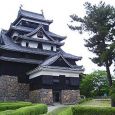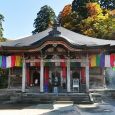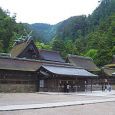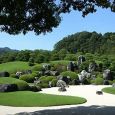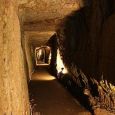Matsue
Advertisement
By plane
Izumo Airport fields flights to major Japanese cities and is about 30 minutes away by car. Direct bus service to Matsue train station. The airport in Yonago, to the east just across the prefectural boundary, is also a viable option and even fields a solitary flight to Seoul.
By train
Matsue is on the San in Main Line, which runs along western Honshu's Japan Sea coast, starting in Kyoto and passing through Tottori and Matsue on its way to Shimonoseki. Frequent Trains run from Okayama to Matsue before continuing to Izumo, departing every hour from 0700 until 2130 daily taking approx 2 hrs 30 mins, costing 5360 yen.
Matsue Castle
Matsue Castle (Matsuejo) is one of only about a dozen original castles in Japan, meaning that its castle tower has survived the wars, fires, earthquakes and anti-feudal activities of the post-feudal era (since 1868).
Matsuejo was completed in 1611 by the local lord Horio Yoshiharu. In 1638, the fief and castle were reassigned to a branch of the Matsudaira clan, relatives of the Tokugawa. The castle tower underwent major renovation works in the 1950s.
Adachi Museum of Art
The Adachi Museum of Art was founded by Adachi Zenko in 1980 as a way of combining his passions for Japanese art and garden design. He hoped that viewing the gardens and artwork together would expand peoples' appreciation and interest in Japanese art.The Adachi Museum of Art is best known for its award winning garden. It has been named the best garden in Japan annually since 2003 by the Journal of Japanese Gardening. The garden can be enjoyed at anytime of the year and shows a different character depending on the season. It can only be viewed from the museum building.
In addition to the gardens, the Adachi Museum of Art also houses a collection of nearly 1300 twentieth century paintings and artworks which are rotated seasonally. There is also a permanent exhibit of paintings by Yokoyama Taikan, as well as a ceramics exhibit.
Izumo Taisha (Izumo Grand Shrine)
Izumo Taisha is Japan's oldest shrine, constructed in a purely Japanese architecture style, called Taisha-tsukuri. The annual gathering place of Shinto's eight million kami ("Shinto gods"), Izumo Taisha is considered Japan's second most important shrine after Ise Jingu.
Izumo Taisha is dedicated to Okuninushi no Mikoto, the nephew of the Sun Goddess. Because Okuninushi is the kami of marriage, visitors clap their hands four times instead of just twice during their prayers, twice for oneself and twice for one's actual or desired partner.
Iwami Ginzan
Iwami Ginzan is a historic silver mine in the mountains of Oda City, Shimane Prefecture. The most prominent silver mine in Japan, it was discovered in the early 16th century and was mined for nearly 400 years.
The main attractions are divided into three areas. The Silver Mine area includes mine shafts and ruins from the area's mining period as well as a few temples and shrines. The Omori Town area includes museums, historical residences, and more shrines and temples.
The final area consists of the onsen town of Yunotsu and nearby port towns, which have their own attractions such as the mooring stones of Okidomari. The port towns are connected to the mining area by two hiking trails that also lead to castle ruins.
The preservation and revitalization of Iwami Ginzan's historic sites began over 50 years ago as a local movement. Eventually gaining prefectural and national support, the area was named a World Heritage Site in July 2007.
Mount Daisen(Daisenji Temple)
Mount Daisen is a large, volcanic mountain that rises up from sea level to dominate the terrain of western Tottori Prefecture. Part of Daisen-Oki National Park, the 1729 meter high mountain is the tallest in the Chugoku Region and is included on the list of Japan's 100 famous mountains. Daisen has not erupted is several thousand years.
As the most prominent mountain far and wide, Daisen has long been a spiritual icon and a center of mountain worship. Daisenji Temple, whose buildings are spread out along the wooded slope and are connected by mountain trails, was built near the base of the mountain and is an important Buddhist temple. Additionally, the Ogamiyama Shrine is found further up the trail above the temple.
March - May


